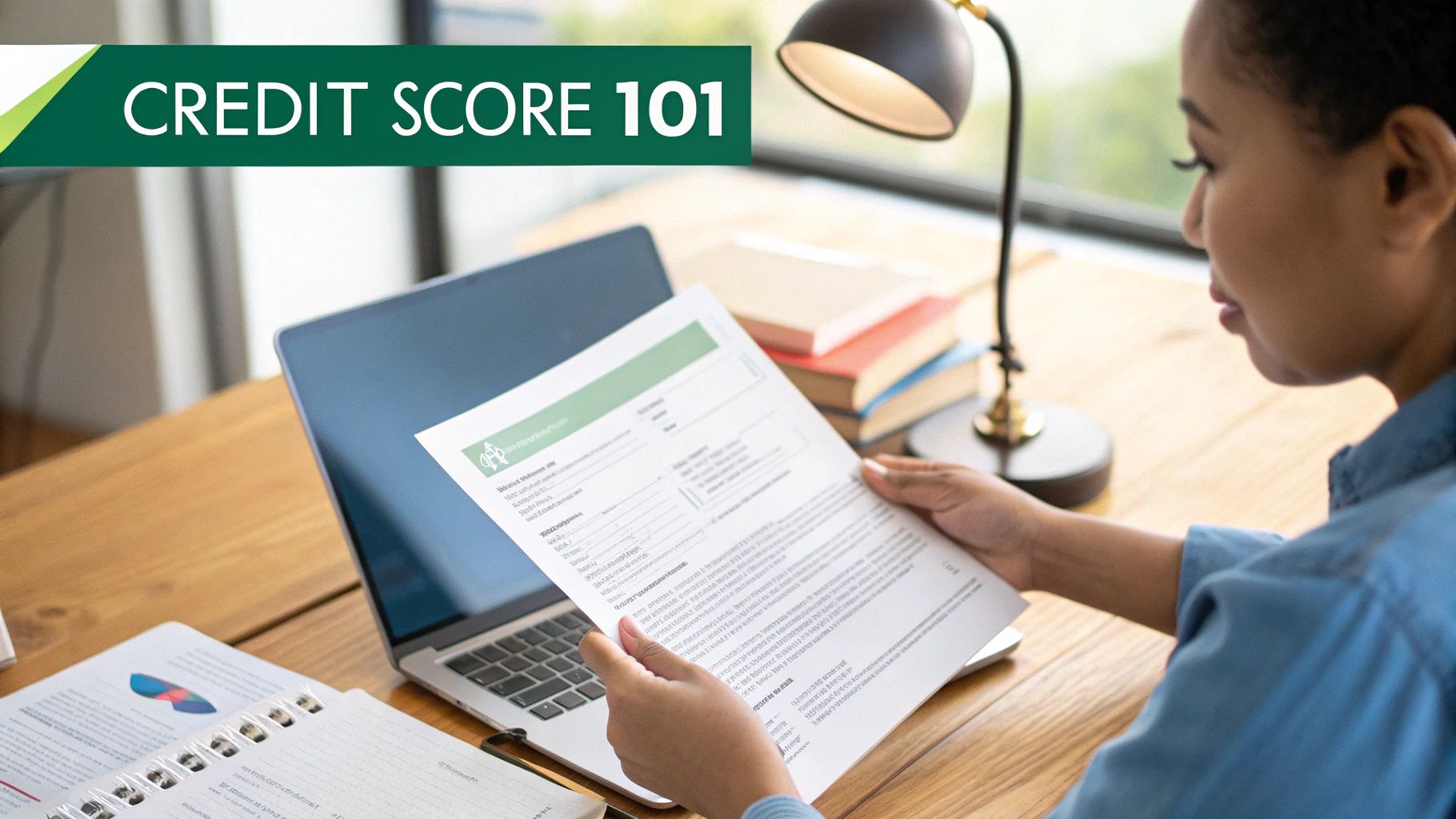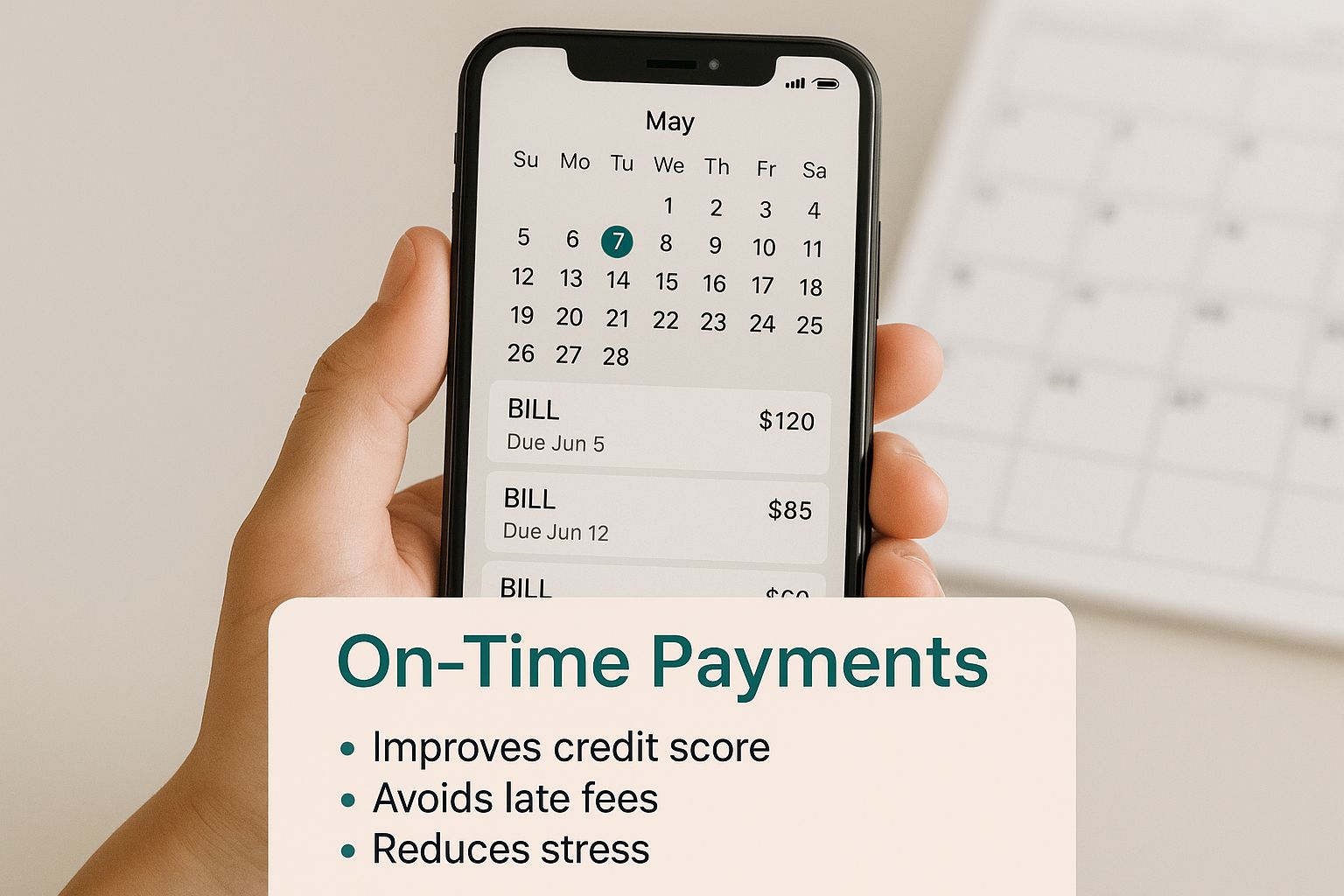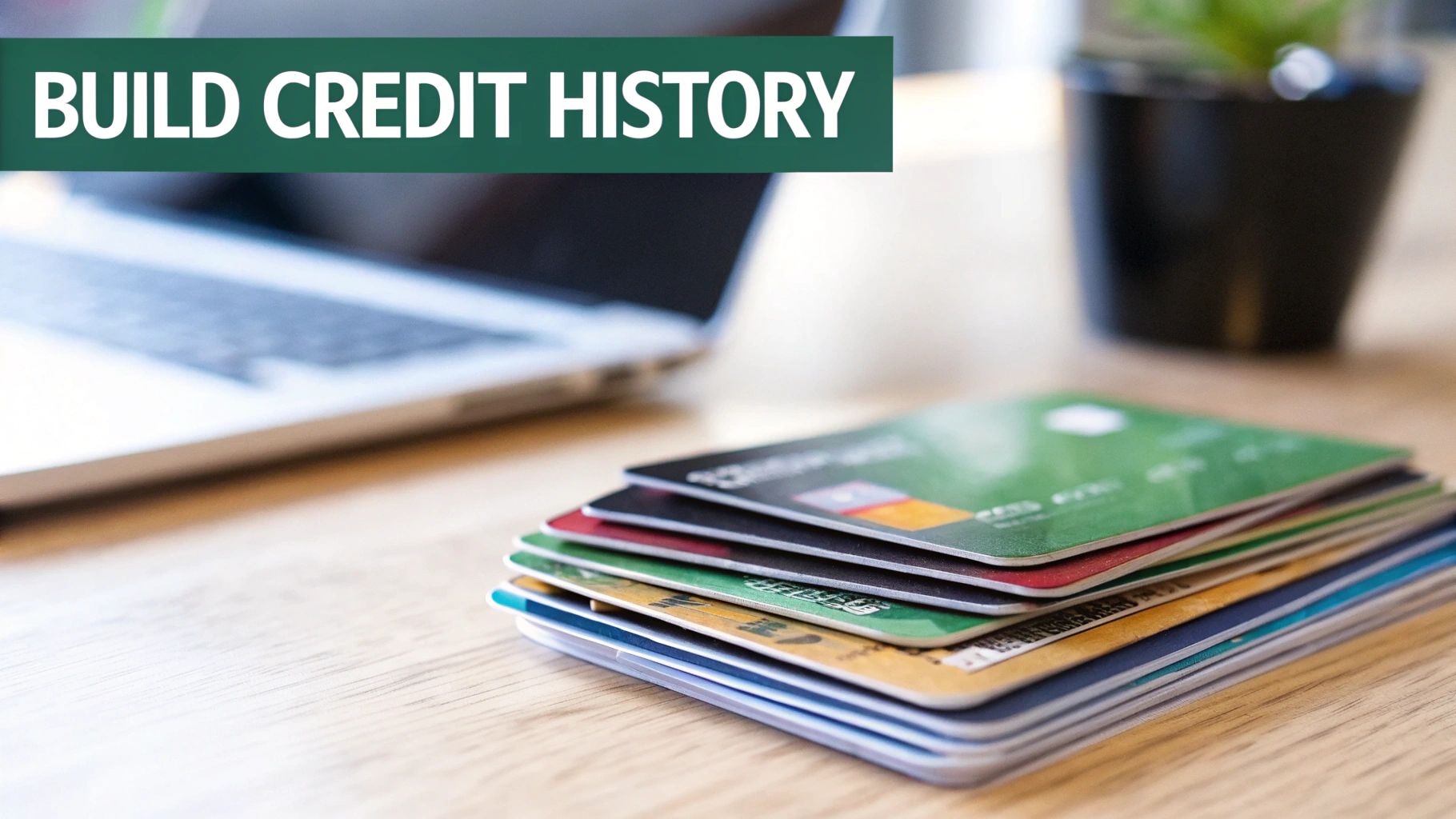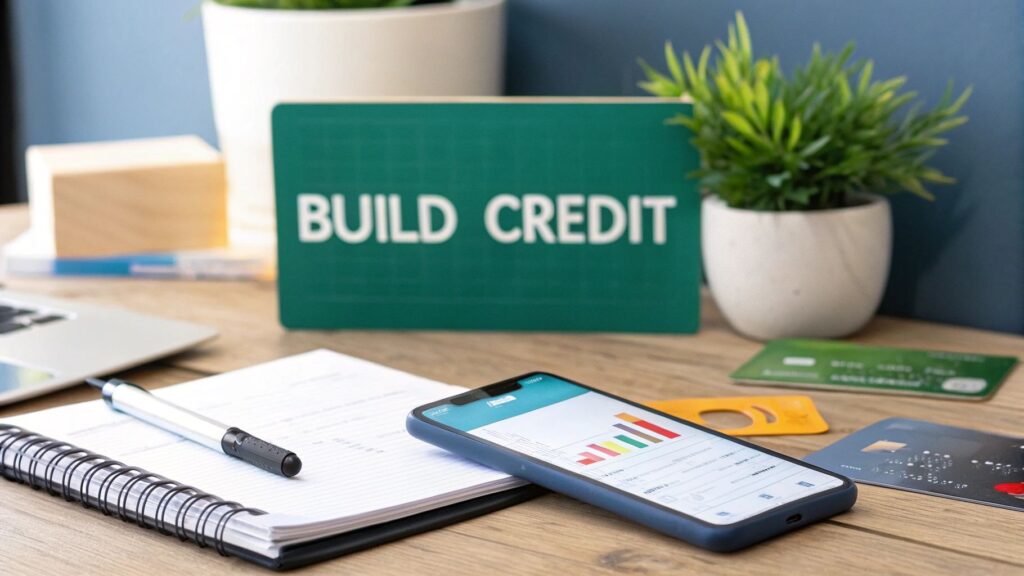Starting from zero credit can feel like a classic catch-22. You need credit to get approved for things, but you can't get approved without a credit history. So, where do you even begin?
The good news is, there are well-worn paths to break this cycle. The very first step is getting a small, manageable line of credit and being absolutely militant about making 100% of your payments on time. This could be a student credit card or even getting added as an authorized user on a parent's card. This simple act of consistent, on-time payments is the cornerstone of a healthy credit history.
Your Starting Point for a Strong Credit Score

Before you can build, you need to know what you're building. While the exact algorithms are kept under lock and key, the major credit bureaus like Experian and Equifax are clear about what they look for. Understanding these core components helps you focus your efforts where they'll have the biggest impact.
What Makes Up Your Credit Score?
Think of your credit score as a grade based on five main subjects. Some subjects are weighted more heavily than others, so acing the important ones is key to getting a good score quickly. Here’s a breakdown of what really matters.
Knowing what goes into your score allows you to create a smart strategy. Let's look at the five main factors that determine your score and how much weight each one carries.
Key Factors That Build Your Credit Score
| Credit Score Factor | What It Means | Impact Level |
|---|---|---|
| Payment History | Do you pay your bills on time? | Very High |
| Amounts Owed | How much of your available credit are you using? | High |
| Length of Credit History | How long have you been managing credit accounts? | Medium |
| Credit Mix | Do you have different types of credit (cards, loans)? | Low |
| New Credit | How often are you applying for new credit lines? | Low |
As you can see, not all factors are created equal. Focusing on your payment history and how much credit you use will give you the most bang for your buck, especially when you're just starting out.
Let’s dig a little deeper into each one.
-
Payment History: This is the big one. It's a simple record of whether you've paid your bills on time. A single late payment can do significant damage, so this should be your top priority.
-
Amounts Owed: Often called credit utilization, this looks at the percentage of your available credit you're currently using. For example, if you have a $1,000 limit and a $200 balance, your utilization is 20%. Keeping this number low (ideally under 30%) is a sign of a responsible borrower.
-
Length of Credit History: Lenders appreciate a long track record. This factor considers the age of your oldest account and the average age of all your accounts combined. This is why it’s often a good idea to keep your oldest card open, even if you don't use it much.
-
Credit Mix: This just means having different kinds of credit, like a credit card, a student loan, and maybe a car loan down the road. It shows you can manage various types of financial responsibilities.
-
New Credit: This keeps an eye on how often you apply for new lines of credit. Applying for several cards or loans in a short time frame can be seen as a sign of financial distress.
Unsurprisingly, your payment history is the single most important piece of the puzzle, making up about 35% of a FICO score. Just one late payment can stay on your credit report for up to seven years, so the discipline you build now really pays off. You can explore more consumer credit trends to see how powerful consistent payments are.
Alright, you landed your first credit card. That’s a huge step. But now comes the important part: actually using it the right way to build a solid credit score.
Think of this card as a tool, not free cash. Your goal is to prove to lenders you can handle debt responsibly, and that starts with forming good habits from day one.
A great way to start is by putting one small, regular purchase on the card—something you already pay for anyway. Think a Netflix subscription, your weekly gas fill-up, or even your morning coffee a few times a week. This creates a predictable payment history without tempting you to overspend.
Keep a Low Balance (A.K.A. Credit Utilization)
One of the biggest factors in your credit score is something called your credit utilization ratio. It sounds complicated, but it's just the percentage of your available credit that you're currently using. So, if you have a $1,000 limit and a $100 balance, your utilization is 10%.
This little number is a big deal, making up about 30% of your FICO score. The golden rule is to keep it below 30%. Seriously. Data from credit bureaus shows that people with scores over 720 consistently keep their utilization low. Let it creep over 50%, and you'll likely see your score take a nosedive. You can dig deeper into how credit trends impact scores on equifax.com.
Don't mistake this for needing a zero balance, though. Showing some small, consistent activity that you pay off promptly is exactly what lenders want to see. It shows you know how to use credit without depending on it.
Never, Ever Miss a Payment
If you only remember one thing, make it this: pay your bill on time, every single time. Your payment history is the single most important part of your credit score, and even one late payment can haunt your credit report for years.
This isn't something to leave to chance. Here’s how to make sure you’re never late:
- Set up autopay. At the very least, schedule an automatic payment for the minimum amount due. This is your safety net. You can (and should) always log in and pay the full balance, but this prevents a disaster if you forget.
- Use calendar reminders. Pop a recurring alert into your phone’s calendar for a few days before the due date. This gives you a buffer to make the payment.
- Actually read your statement. When your statement arrives, take two minutes to look it over. Check for weird charges and confirm the payment date. It’s a simple habit that catches problems early.
Building credit isn't about complex financial wizardry. It's about these small, consistent actions that prove you're reliable. Master these basics with your first card, and you'll be setting yourself up for a much easier financial future.
Credit Building Strategies for Young Adults
Starting out as a young adult often means you have what's called a "thin" credit file. It’s not that you have bad credit; you just don't have enough history for lenders to feel confident. This can make getting that first credit card or a small loan feel like an uphill battle.
The good news? There are tools designed specifically for this situation.
Getting Started: Secured Cards and Credit-Builder Loans
One of the best on-ramps to good credit is a secured credit card. Think of it as a credit card with training wheels. You put down a refundable cash deposit—usually a few hundred dollars—and that amount becomes your credit limit. For the bank, this takes away the risk, which is why they’re much easier to get approved for, even with zero credit history.
Then there’s the credit-builder loan. This one works in reverse. Instead of getting cash upfront, you make small, regular payments into a locked savings account held by the lender. After you've paid off the full loan amount, the money is yours. It’s a clever way to prove you can handle payments while also building up some savings.
Which One Makes Sense for You?
Both of these tools report your payment history to the major credit bureaus, and that's exactly what you need to build a solid score. The choice really comes down to your personal habits.
- A secured card is perfect if you want the convenience of a card for small, planned purchases—like gas or your monthly streaming service—that you can pay off in full right away.
- A credit-builder loan is a better fit if you want a disciplined approach. It forces you to save and build credit simultaneously, without giving you a new way to spend.
It's more important than ever for young people to get this right. Recent data shows Gen Z's average credit score has dipped to 676, a full 39 points below the national average of 715. You can read more about this trend from The Week and see why starting smart is so crucial.
The core principle behind building good credit is surprisingly simple: consistency.

No matter which path you choose, making your payments on time, every single time, is the golden rule. Juggling these new financial habits with school costs can be a real balancing act. If you're looking for more tips on managing your money, our guide on how to plan for college expenses can help you stay on top of everything.
Common Credit Mistakes to Sidestep
Knowing the right moves to build your credit score is great, but knowing what not to do is just as crucial. It's surprisingly easy to undo all your hard work with a few seemingly innocent mistakes. Let's walk through some of the most common traps I've seen trip people up.
Getting those first pre-approved credit card offers in the mail feels like a rite of passage. It's tempting to apply for a few at once to see which ones you get. Resist that urge. Every time you apply, the lender pulls your file, creating a hard inquiry on your credit report.
Too many of these in a short time can knock a few points off your score. More importantly, it makes you look desperate for credit, which is a major red flag for lenders.
Closing Your Oldest Credit Card
Once you have a few cards, it might feel smart to close that first "starter" card you don't really use anymore. Don't do it. A huge piece of your credit score is your length of credit history, and that old account is the anchor.
Closing it instantly shortens your credit history, which can cause your score to drop. A better idea? Keep it open. Use it once every few months for a small purchase—like a streaming subscription or a cup of coffee—and set up autopay. This keeps the account active and preserves all that valuable history you've built.
The Dangers of Co-signing
Sooner or later, a friend or family member might ask you to co-sign a loan for them. While you might want to help, you need to understand what you're really agreeing to. When you co-sign, you're telling the bank you are 100% responsible for the debt if the main borrower can't pay.
Any missed payments they make show up on your credit report, dragging your score down with them. The entire loan amount also gets added to your total debt, which can make it much harder for you to get a car loan or mortgage of your own down the line.
This applies to all kinds of debt, including a line of credit. It's vital to know how to use a line of credit without turning it into long-term debt before getting involved. Seriously, think twice—and then a third time—before tying your financial future to someone else's payment habits.
How to Track and Protect Your Credit Health

Trying to build your credit without actually checking on it is like driving with your eyes half-closed. You think you're heading in the right direction, but you can't spot trouble until it's too late. To really stay on top of your financial health, you need to make monitoring your credit a regular habit.
Your first stop should be pulling your free credit reports. Thanks to federal law, you're entitled to a free report every single year from each of the three main credit bureaus: Equifax, Experian, and TransUnion. The only place to get these official reports is AnnualCreditReport.com.
Here's a pro tip: don't pull all three at once. Stagger them. Grab one every four months from a different bureau. This strategy gives you a free, year-round look at what’s happening with your credit file.
What to Look For on Your Credit Report
Once you have your report, it's time to play detective. Don't just give it a quick scan; you need to review it line by line for any inaccuracies that could be unfairly pulling your score down.
Look for anything suspicious, such as:
- Accounts you never opened.
- Payments marked as late when you know you paid on time.
- Personal information that isn't yours.
These mistakes can be simple clerical errors, but they can also be the first warning sign of identity theft.
Spotting unauthorized activity early is critical. If something looks off, act fast. Promptly disputing errors with the credit bureaus can protect you from serious damage, especially during times of financial distress. Check out our guide on how to dodge fraudsters when you're in financial distress for more protective strategies.
It’s also important to understand the difference between your credit report and your credit score. Think of the report as your full financial history, while the score is the grade you get based on that history. Your free annual reports show the history, but they don't usually include the score itself.
Thankfully, getting your score is easier than ever. Many banks and credit card issuers now offer free FICO or VantageScore access right in their apps. You can also use free services like Credit Karma to monitor your score and see how it changes over time.
This kind of vigilance is more important than you might think. After more than a decade of steady growth, the average FICO score in the U.S. recently dipped from 718 to 715, partly because of rising debt and missed payments. In a shaky economy, even small financial slips can have a bigger impact than usual. You can discover more insights about this credit score decline on cbsnews.com. Keeping a close watch helps you stay in control.
Your Top Credit-Building Questions, Answered
When you're first figuring out how to build credit, a few questions always seem to come up. It's totally normal. Let's walk through the most common ones so you can feel confident about your game plan.
How Long Does It Realistically Take to Get a Good Score?
Building a good credit score is definitely more of a marathon than a sprint. You'll need at least six months of credit history just to generate your first FICO® Score, but getting into that "good" range—think 700 or higher—takes more time.
Realistically, you should expect to spend about one to two years building up a solid history. The key is consistency. That means always paying on time, keeping your balances low, and not applying for a bunch of new cards at once. That steady, positive track record is what lenders really want to see.
Will Checking My Own Credit Score Hurt It?
This is a huge myth, and the short answer is no, it won't. When you check your own score—whether it's through your bank's mobile app or a service like Credit Karma—it's called a soft inquiry. These have absolutely zero impact on your score.
A hard inquiry is different. That’s when a lender pulls your report because you've formally applied for something like a new credit card, an apartment, or a car loan. Those can cause a small, temporary dip in your score. So, go ahead and check your score as often as you like. It's one of the smartest financial habits you can build.
The goal isn’t just to get a number—it’s to build a story. A good credit history tells lenders that you can borrow money and pay it back responsibly. That history is the bedrock of a healthy financial future.
Should I Use My Credit Card or Just Let It Sit?
Definitely use it! An open credit card that you never use isn't really doing much to help you. Lenders need to see that you're actively and responsibly managing your credit.
The best approach is to use your card for a small, predictable purchase each month. Think of your Netflix subscription or your weekly coffee run. Then, make sure you pay the entire balance off before the due date. This proves you can handle credit without falling into debt, and it adds fresh, positive payment data to your credit report month after month.
At Cynthia Gardens, we get that building a solid financial foundation is a huge step for students and young professionals. If you're looking for an apartment community that supports your goals, come see what we have to offer at https://cynthiagardens.com.
